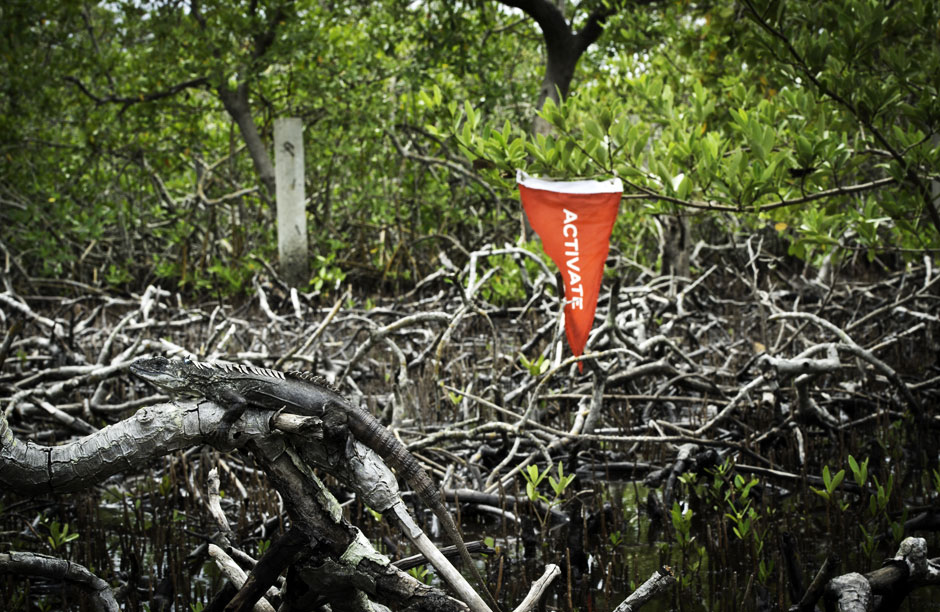PROJECT
Flag #12: Honduras
Location: Utila Islands, Honduras
Name: Maja Zonjic
Despite being one of the three most productive ecosystems globally – alongside rain forests and coral reefs – the world’s mangrove forests are disappearing rapidly due to the effects of eutrophication, unsustainable construction practices – including coastal/residential development and civil engineering projects – as well as aquaculture conversion. As an invaluable economic and ecological resource, mangroves are breeding sites and nursery grounds for reptiles, mammals, fish, birds and crustaceans as well as sediment, carbon, nutrient and contaminant accumulation sites, renewable sources of wood, and finally, natural barriers against coastal erosion or hurricanes. Although guidelines have been developed by several agencies for the sustainable management of mangroves, many scholars wonder if it is too late for reforestation programs and other initiatives as the loss of biodiversity from old-growth forests is unlikely to be regained, and potentially lost permanently.
In Utila, Honduras, there are 4 mangrove species, the red, (Rhizophora mangle), the white (Laguncularia racemosa), the black (Avicennia germinans) and the buttonwood mangrove (Conosarpus erectus). Lying off the coast of the Mesoamerican Barrier Reef system – the second largest in the world – Utila has experienced a colossal dive tourism boom in the recent decades as one of the cheapest places globally to obtain a PADI Open Water certification. Although the land territory of Utila is only about 40 km2 , with two-thirds – as a conservative estimate – of it under mangrove coverage several decades ago, it now boasts more than 60 dive sites and dozens of dive shops, hotels, restaurants, and related tourist infrastructure. Although already severely decimated, Utila’s mangroves are in danger of disappearing entirely due to factors that could be linked to the recent tourist boom, most notably; anthropogenic stresses and over-population, and in conjunction with it, demand for housing, space and property development. Additionally, in Utila, mangroves are especially important as they house the endemic and critically endangered Swamper Iguana specie (Ctenosaura bakeri) – currently residing in a range of less than 8 km2 globally – and are also one of the only two natural barriers against inclement weather conditions. In 2010, it was assessed by the IUCN as critically endangered due to overhunting and habitat loss / fragmentation and Honduran law has protected the species since 1994, when a hunting ban has been put in place. The Iguana Station has been built in 1998 in order to implement protection, breeding and educational programs to increase the numbers and stability of the Swamper Iguanas in the wild. In the recent years, another NGO and research station, Kanahau, has opened up as well, and currently works in detailed population studies of the Swampers, as well as the island’s other animal species. Conservation activities on the island are difficult to implement and get minimal government support, amplifying the general lack of education surrounding the specie on both the locals’ as well as tourists’ part. Despite the staggering conditions, in my 2011 MFA thesis survey of Utila’s tourists, 60% of those surveyed felt that the mangrove health in Utila is good or fair, and 24% reported the same opinions for the Swampers.
Exacerbating the issue, and despite the presence of two other larger iguana types on the island – the Highlander and the Green Iguana – the Swamper is hunted locally for its meat and eggs. It is considered a delicacy and part of a traditional Utilian diet, and its’ street value is priced at approximately 85 Lempiras per pound – twice the price of beef, and more than three times the price of chicken. It is also important to note is that few people actually hunt iguanas in the mangroves; rather they wait until the gravid females move to the beach to lay their eggs, where they are much easier to catch. This affects two generations of iguanas – the females and the offspring, and many Utilian locals have noted seeing people catching forty at a time, as opposed to one or two to feed the family. The practice of capturing gravid females has resulted in a serious population imbalance, and some conservationists have noted that for every female Swamper, there are two males. They have also said that beans, tortillas and other traditional, sustainable sources of food are inexpensive on the island, and that poverty is not an excuse to capture the Swampers, since most of the islanders can afford the aforementioned alternatives.
With new housing developments and hotel expansions occurring daily and devastating the Swamper habitat, conservationists fear that the fate of this beautiful specie is bleak, unless drastic measures are taken by both the local and national government to protect it. In the meantime, it is up to the locals, and the tourists to do their part in ensuring its’ survival. Simple ways of helping include not supporting the businesses, or developing and buying property that lies on former filled-in mangrove stands, and obviously, not consuming the Swamper iguana. For those who want to do more, both Kanahau and the Iguana Station accept volunteers, and help offset some of their operating costs through minimal volunteer fees. Finally, help spread awareness! See www.postcards-from-utila.com for more details, and check out In the Land of the Swamper in Red Flag Magazine’s Animal issue.
